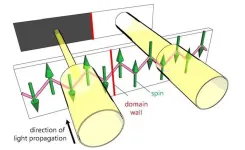(Press-News.org)
When something draws us in like a magnet, we take a closer look. When magnets draw in physicists, they take a quantum look.
Scientists from Osaka Metropolitan University and the University of Tokyo have successfully used light to visualize tiny magnetic regions, known as magnetic domains, in a specialized quantum material. Moreover, they successfully manipulated these regions by the application of an electric field. Their findings offer new insights into the complex behavior of magnetic materials at the quantum level, paving the way for future technological advances.
Most of us are familiar with magnets that stick to metal surfaces. But what about those that do not? Among these are antiferromagnets, which have become a major focus of technology developers worldwide.
Antiferromagnets are magnetic materials in which magnetic forces, or spins, point in opposite directions, canceling each other out and resulting in no net magnetic field. Consequently, these materials neither have distinct north and south poles nor behave like traditional ferromagnets.
Antiferromagnets, especially those with quasi-one-dimensional quantum properties — meaning their magnetic characteristics are mainly confined to one-dimensional chains of atoms — are considered potential candidates for next-generation electronics and memory devices. However, the distinctiveness of antiferromagnetic materials does not lie only in their lack of attraction to metallic surfaces, and studying these promising yet challenging materials is not an easy task.
“Observing magnetic domains in quasi-one-dimensional quantum antiferromagnetic materials has been difficult due to their low magnetic transition temperatures and small magnetic moments,” said Kenta Kimura, an associate professor at Osaka Metropolitan University and lead author of the study.
Magnetic domains are small regions within magnetic materials where the spins of atoms align in the same direction. The boundaries between these domains are called domain walls.
Since traditional observation methods proved ineffective, the research team took a creative look at the quasi-one-dimensional quantum antiferromagnet BaCu2Si2O7. They took advantage of nonreciprocal directional dichroism — a phenomenon where the light absorption of a material changes upon the reversal of the direction of light or its magnetic moments. This allowed them to visualize magnetic domains within BaCu2Si2O7, revealing that opposite domains coexist within a single crystal, and that their domain walls primarily aligned along specific atomic chains, or spin chains.
“Seeing is believing and understanding starts with direct observation,” Kimura said. “I’m thrilled we could visualize the magnetic domains of these quantum antiferromagnets using a simple optical microscope.”
The team also demonstrated that these domain walls can be moved using an electric field, thanks to a phenomenon called magnetoelectric coupling, where magnetic and electric properties are interconnected. Even when moving, the domain walls maintained their original direction.
“This optical microscopy method is straightforward and fast, potentially allowing real-time visualization of moving domain walls in the future,” Kimura said.
This study marks a significant step forward in understanding and manipulating quantum materials, opening up new possibilities for technological applications and exploring new frontiers in physics that could lead to the development of future quantum devices and materials.
“Applying this observation method to various quasi-one-dimensional quantum antiferromagnets could provide new insights into how quantum fluctuations affect the formation and movement of magnetic domains, aiding in the design of next-generation electronics using antiferromagnetic materials,” Kimura said.
Their study was published in Physical Review Letters.
###
About OMU
Established in Osaka as one of the largest public universities in Japan, Osaka Metropolitan University is committed to shaping the future of society through “Convergence of Knowledge” and the promotion of world-class research. For more research news, visit https://www.omu.ac.jp/en/ and follow us on social media: X, Facebook, Instagram, LinkedIn.
END
Being a teenager is hard, confusing — and crucially important. Scientists studying teenage socializing have found that teenaged friendships could lay essential foundations for wellbeing in later life, and that not just the kinds of friendships teenagers experience but the timing of those friendships is critical.
“A teen’s perception of how broadly socially accepted they are by their peers in early adolescence is particularly influential in predicting adult wellbeing,” said Emily Shah of the University of Arkansas, first author of the article in Frontiers in Developmental Psychology. “Conversely, in late adolescence, the quality of their more ...
Hawaii could soon be welcoming a new distillery after a postgraduate student at Scotland’s Heriot-Watt University won a prestigious entrepreneurial award.
Canadian student Ethan Wang, 42, wants to open a new distillery on Hawaii’s scenic volcanic island of Maui and said he was in “total shock” after winning cash and support from an industry membership organisation to help make his idea happen.
The award, called the Worshipful Company of Distillers’ Entrepreneurship Award, is designed to help students apply their science in the real world and is run jointly by Heriot-Watt’s respected International Centre for Brewing and Distilling and The Worshipful Company ...
Trinity researchers find ‘natural killer’ cells that live in the lung are ready for a sugar rush
Trinity College Dublin researchers, based at St James’s Hospital have provided important insights into the behaviour and metabolic function of a previously largely unknown, but crucial ‘natural killer’ (NK) immune cell resident in the lungs. Their findings, published today [Thursday, 10th October 2024] in the journal: Proceedings of the National Academy of Sciences (PNAS) provide ...
University of California San Diego and University of California Berkeley researchers have been awarded up to $7 million from the Advanced Research Projects Agency for Health (ARPA-H) to conduct research under the PROTECT project — Pro/Prebiotic Regulation for Optimized Treatment and Eradication of Clinical Threats. The project targets pathogens such as Pseudomonas aeruginosa and potentially Staphylococcus aureus, which pose significant health risks for individuals with cystic fibrosis and those dependent on respirators. PROTECT co-principal investigators are ...
Breakdancers may be at risk of developing a condition caused by repeatedly doing a cardinal move of their practice and performance—the headspin—warn doctors in the journal BMJ Case Reports.
Dubbed the ‘headspin hole,’ or ‘breakdance bulge,’ the condition is unique to breakdancers, and appears as a protruding lump on the scalp, often accompanied by hair loss and tenderness.
Breakdancers are particularly prone to injuries because of the complexities and physical demands of the moves, note the authors. Sprains, strains, and tendinitis are particularly common. Head and brain injuries, including subdural haematomas (pooling ...
Patients shouldn’t rely on AI powered search engines and chatbots to always give them accurate and safe information on drugs, conclude researchers in the journal BMJ Quality & Safety, after finding a considerable number of answers were wrong or potentially harmful.
What’s more, the complexity of the answers provided might make it difficult for patients to fully understand them without a degree level education, add the researchers.
In February 2023, search engines underwent a significant shift thanks to the introduction ...
DALLAS, October 10, 2024 — Across the United States, more than 90% of stroke patients have some form of disability as a result and more than 11% experience a second stroke within a year. This risk weighs particularly heavily on people living in rural areas, who may face challenges accessing health care.
The American Heart Association, with support from The Leona M. and Harry B. Helmsley Charitable Trust, has committed $4.7 million in Minnesota and $5.05 million in South Dakota to strengthen the full spectrum of stroke care across ...
HOUSTON, October 10, 2024 — Former University of Georgia and University of Miami football coach Mark Richt has been named the recipient of the American Heart Association’s 2025 Paul 'Bear' Bryant Heart of a Champion Award presented by Houston (Texas) based-St. Luke’s Health, honoring his exceptional contributions to college football and the community while supporting the Association’s relentless pursuit of a world of longer, healthier lives for everyone everywhere. The Heart of a Champion Award recognizes individuals whose notable contributions ...
Researchers at UTHealth Houston have been awarded an $8.1 million grant by the National Institutes of Health (NIH) to examine skeletal stem cells as potential drivers of craniofacial bone diseases and deformities. The study is led by Noriaki Ono, DDS, PhD, associate professor of orthodontics, and diagnostic and biomedical sciences at UTHealth Houston School of Dentistry.
Bones in the craniofacial region are highly susceptible to diseases because of the demands of chewing, breathing, and swallowing, which can impact bone growth and regeneration. In previous research, Ono identified a type ...
About 20% of children as young as age 3 have an identified mental health problem
Can mark the beginning of a negatively spiraling mental health course as children grow
Poor mental health in toddlers can be reversed if addressed early
CHICAGO --- Northwestern University has launched a new Mental Health, Earlier Center at the Institute for Innovations in Developmental Sciences (DevSci), thanks to an $11.7 million award from the National Institute of Mental Health (NIMH) of the National Institutes of Health.
Co-led by researchers at the Spencer Fox Eccles School of Medicine at the University of Utah, the center will address ...



